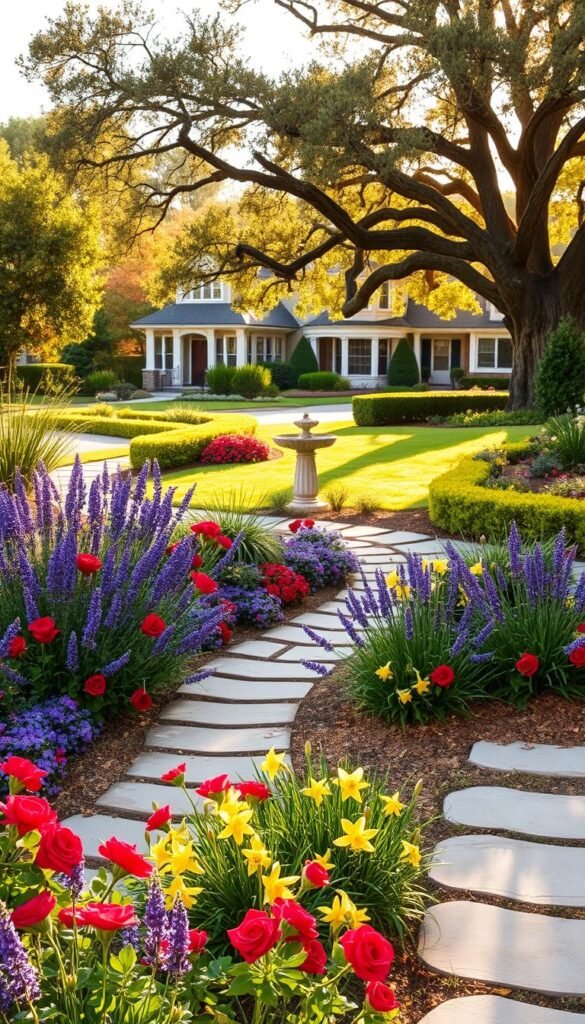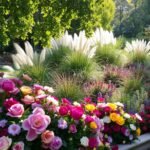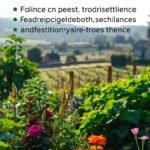Your front yard is more than just grass and pavement—it’s the first impression your property makes. Whether you’re greeting guests or simply coming home, a thoughtfully designed space can elevate your house’s character while increasing its market value. Let’s explore how to turn this area into a welcoming showcase that mirrors your personal taste.
Strategic landscaping does more than look pretty. It works with your home’s architecture to create harmony. For example, matching plant heights to your porch columns or choosing colors that complement your exterior paint can make everything feel intentional. Even small tweaks, like adding a stone path or decorative pots, deliver big visual rewards.
Plants are the backbone of great design, but they need to thrive to look their best. Always check plant tags for sunlight and soil needs before buying. Picking the right species for your climate prevents wasted time and money. Native plants often require less maintenance while supporting local ecosystems.
You don’t need a full renovation to make an impact. Focus on focal points like a vibrant flower bed or a statement tree. Layer textures with shrubs and ground cover to add depth. These budget-friendly changes prove that curb appeal isn’t about perfection—it’s about creating a space that feels alive and inviting.
Understanding Your Front Yard’s Potential
Every outdoor space holds unique opportunities waiting to be unlocked. Start by walking your property with fresh eyes—imagine blank areas as future flower beds and existing features as design anchors.
Map Your Canvas
Grab a tape measure and sketchpad to document your space dimensions. Note permanent elements like driveways or mature trees that influence your layout. Track sunlight patterns over three days—morning rays differ from afternoon intensity.
| Light Condition | Plant Examples | Water Needs |
|---|---|---|
| Full Sun (6+ hours) | Lavender, Sedum | Low |
| Partial Shade | Hydrangea, Hosta | Moderate |
| Full Shade | Ferns, Astilbe | High |
Clarify Your Vision
Ask yourself: Do you want weekend relaxation spots or year-round color displays? Maybe you need kid-friendly zones or drought-resistant landscaping. Prioritize changes that align with your daily life while boosting visual impact.
Remember, successful design works with nature—not against it. That north-facing corner under your maple tree? Perfect for shade-loving ground cover instead of struggling grass. Your sunny walkway border? Ideal for cheerful daisies that greet visitors.
Designing a Welcoming Entryway
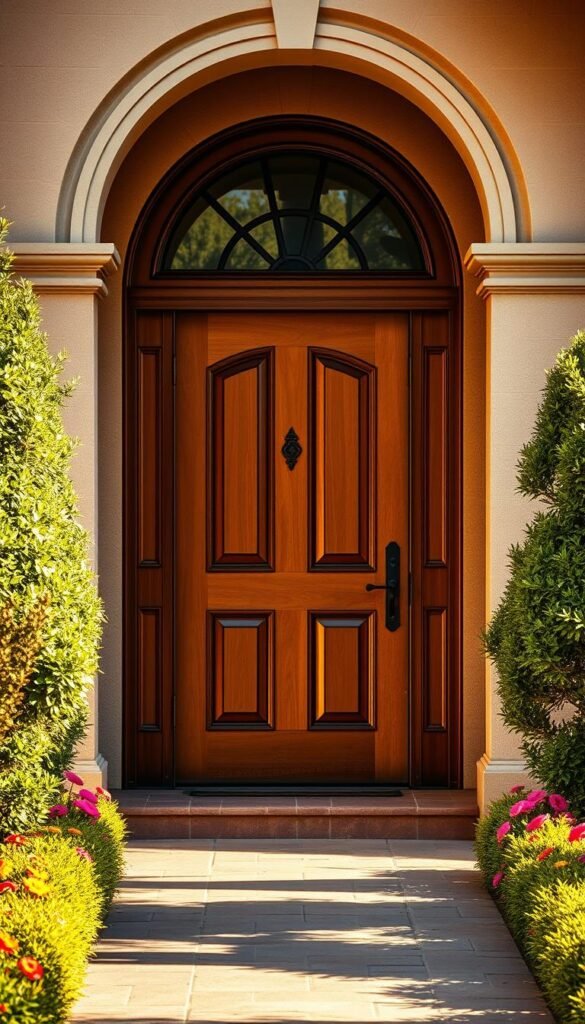
Your entryway sets the tone for your entire home. A few intentional choices can transform this transitional space into an inviting experience that reflects your personality while maximizing curb appeal.
Elevate Your Front Door’s Charm
Your front door acts as both greeting card and centerpiece. Frame it with matching planters featuring seasonal blooms—pansies in spring transition to summer geraniums, then autumnal mums. For year-round structure, try boxwood topiaries or dwarf conifers in weatherproof pots.
Build Layers of Warmth
Create visual interest through strategic accents:
- A textured doormat anchors the space
- Symmetrical lanterns flanking the door add balance
- Hanging baskets introduce vertical dimension
Color psychology plays a key role here. While red remains popular for its welcoming energy, softer hues like sage green or navy can complement modern exteriors. As designer Emily Henderson notes:
“Your entry color should whisper ‘come in’ rather than shout for attention.”
Complete the look with a wreath that changes seasonally—fresh eucalyptus in winter, dried lavender in summer. These thoughtful touches guide visitors’ eyes toward your focal point while making every homecoming feel special.
Planning Your Front Yard Makeover
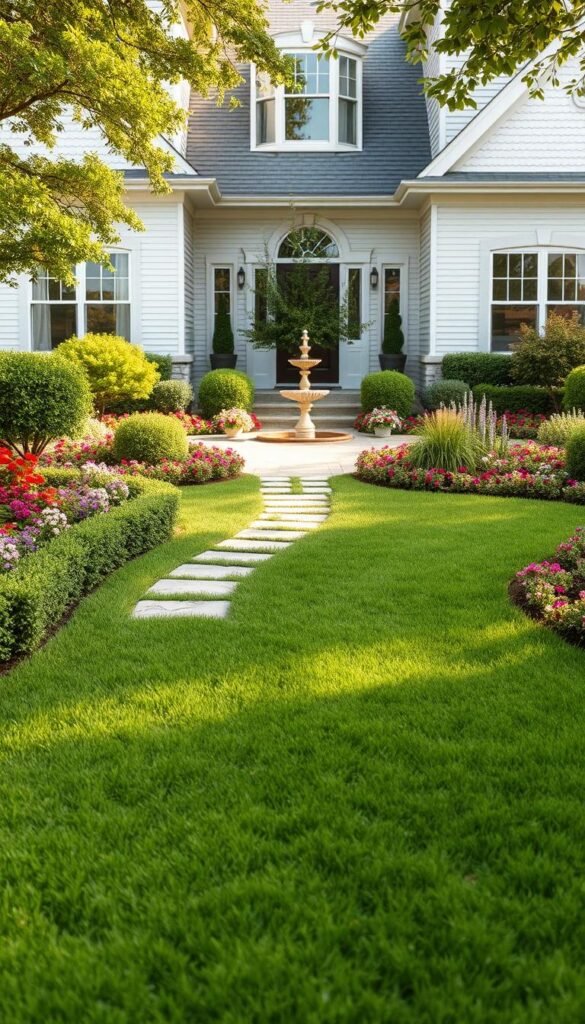
Transforming your outdoor space starts with smart preparation. Before grabbing your shovel, take time to create a roadmap that balances vision with practicality. This approach ensures every dollar and hour spent delivers maximum impact.
Setting a Budget and Timeline
Begin by deciding what you can comfortably spend. Many budget-friendly ideas exist—like building stone edging from reclaimed materials or crafting solar path lights. Allocate funds strategically: 50% for structural changes, 30% for plants, and 20% for accents.
Break projects into phases to manage your time effectively:
- Week 1-2: Install pathways or retaining walls
- Week 3-4: Add soil amendments and begin planting
- Week 5+: Incorporate decorative elements like mulch or statues
This staggered approach prevents burnout while letting each layer settle properly.
Mapping Out a Design Plan
Sketch your vision using grid paper or free apps like iScape. Mark existing trees, slopes, and sunny zones first. Then layer in new elements:
| Element | Spacing Guide | Growth Consideration |
|---|---|---|
| Shrubs | 3-5 ft apart | Mature width x 1.5 |
| Perennials | 12-18″ apart | Height at maturity |
| Pathways | 36″ minimum | N/A |
Prioritize changes offering instant visual returns—like refreshing mulch beds—while allowing slower-growing plants to develop. This balance keeps your yard looking polished through every growth stage.
Key Elements of Effective Yard Landscaping
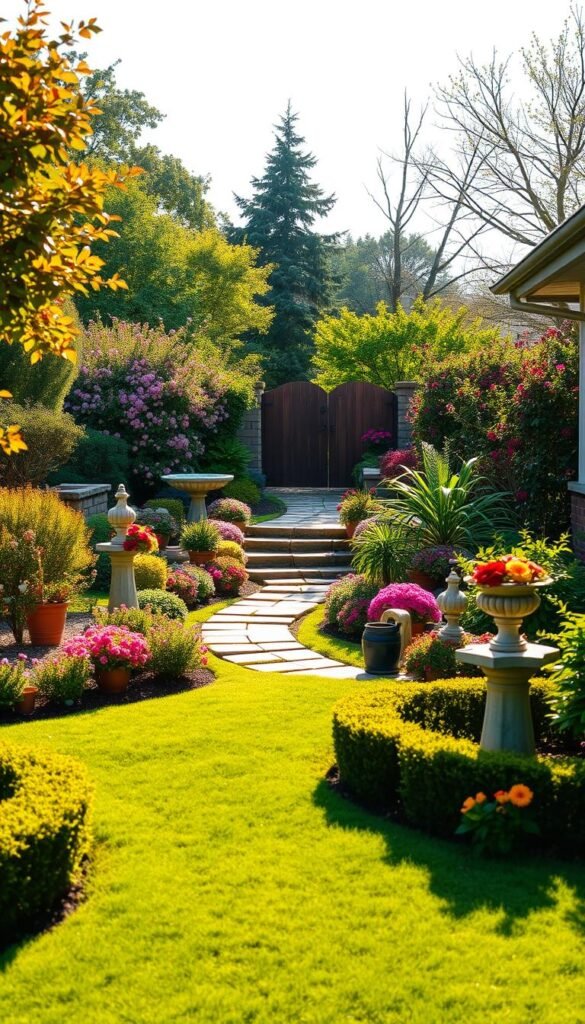
Great yard landscaping balances beauty with practicality. The right mix of plants creates visual harmony while reducing upkeep. Let’s break down how to layer trees, shrubs, and perennials for a polished, low-maintenance space.
Strategic Plant Selection
Flowering trees like Kousa dogwood and redbud deliver big impact with minimal work. Their disease-resistant nature means fewer treatments, while seasonal blooms add bursts of color without messy cleanup. These trees anchor your design while framing your home’s architecture.
Perennials are the gift that keeps giving. Sun-loving catmint blooms for months, attracting pollinators. Coreopsis thrives in poor soil, perfect for tricky spots. In shaded areas, coral bells offer colorful foliage, while dicentra’s heart-shaped flowers bring charm.
| Plant Type | Examples | Key Benefits | Care Needs |
|---|---|---|---|
| Flowering Trees | Redbud, Kousa Dogwood | Year-round structure, seasonal color | Annual pruning |
| Shrubs | Boxwood, Hydrangea | Privacy screening, texture | Seasonal trimming |
| Perennials | Catmint, Coral Bells | Long-lasting blooms, cost-effective | Dividing every 3-5 years |
Create depth by layering heights. Place taller shrubs behind mid-sized perennials, with groundcovers at the base. This professional approach hides bare soil while showcasing each plant’s best features.
Remember: Smart choices today mean less work tomorrow. Opt for native species adapted to your region’s rainfall and pests. Your future self will thank you when watering days shrink but beauty remains.
Creative Ideas for Front Yard Landscaping
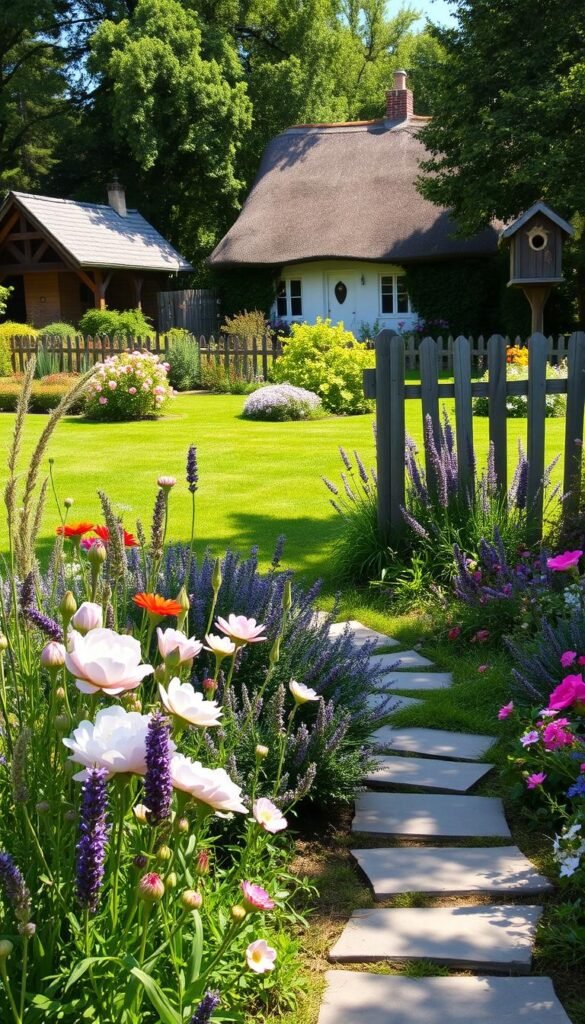
Blending natural charm with intentional structure transforms ordinary yards into captivating spaces. The secret lies in balancing free-flowing elements with crisp lines—a formula that delivers personality without sacrificing practicality.
Nature’s Playbook Meets Clean Geometry
Cottage-style gardens prove that beauty thrives in controlled chaos. Letting perennials like coneflowers spill over pathways creates a lived-in feel, while clustered lavender bushes soften stone borders. This approach reduces upkeep since plants aren’t forced into rigid shapes.
For instant polish, try mass plantings of single species. A row of boxwoods along your walkway establishes order, while catmint drifts in flower beds add softness. Landscape architect Thomas Rainer suggests:
“Pairing repetition with spontaneity makes spaces feel designed yet alive.”
Three strategies merge styles seamlessly:
- Frame wildflower patches with trimmed hedges
- Use gravel paths to separate lush planting zones
- Anchor corners with symmetrical shrubs
Your yard becomes a conversation between contrasting elements. Ornamental grasses sway beside geometric pavers, and climbing roses soften angular fences. This interplay keeps eyes moving while maintaining harmony with your home’s architecture.
Inspiring Front Garden Ideas to Boost Your Home’s Curb Appeal
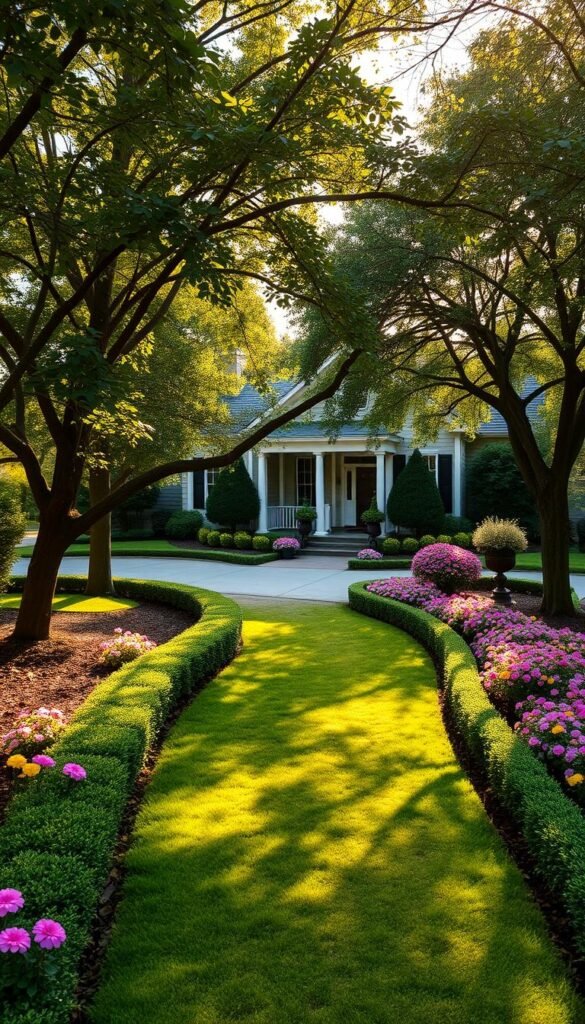
Your driveway doesn’t have to be just functional—it can become a design feature. Breaking up asphalt expanses with central planting beds adds life to paved areas while softening harsh lines. This approach works especially well for circular or U-shaped layouts, where greenery creates natural focal points.
Raised beds redefine space with clear boundaries. Using materials like natural stone or brick elevates plants for better visibility from the street. These structures also improve drainage, giving roots room to breathe compared to ground-level plantings.
| Driveway Type | Bed Shape | Plant Suggestions | Maintenance Level |
|---|---|---|---|
| Circular | Oval centerpiece | Dwarf spruce, ornamental grasses | Low |
| U-Shaped | Curved borders | Lavender, sedum | Moderate |
| Straight | Linear strips | Boxwood, daylilies | High |
Landscape designer Marcus Barnett notes:
“Strategic green islands in driveways balance hardscape with nature—they guide movement while making spaces feel intentional.”
For lasting impact, choose materials matching your home’s exterior. Flagstone beds complement rustic styles, while sleek concrete planters suit modern facades. Position taller plants near the road to frame your property without blocking views.
These changes transform overlooked areas into value-boosting features. Your front yard gains depth, and visitors immediately notice the curb appeal upgrade. Best of all, these beds require minimal upkeep once established—a win for busy homeowners.
Eco-Friendly and Low-Maintenance Solutions
Smart landscaping choices can beautify your space while conserving resources. By selecting resilient varieties and water-wise techniques, you create a vibrant yard that thrives with minimal effort.
Drought-Tolerant Plants and Xeriscaping
Russian sage and lavender are superheroes in dry conditions. Once established, these perennials bloom for weeks with sporadic watering. Their silvery foliage adds texture, while fragrant flowers attract bees and butterflies naturally.
Sedum offers versatile options for groundcover or container displays. These succulents store water in their leaves, surviving weeks without irrigation. Cluster them in rock gardens or mix varieties in trough planters for movable color accents.
| Plant Type | Water Needs | Maintenance Level |
|---|---|---|
| Lavender | Low | Annual pruning |
| Sedum | Very Low | None |
| Russian Sage | Moderate | Cut back in spring |
Xeriscaping principles help you design efficiently. Landscape designer Lauren Dunec Hoang explains:
“Group plants by water needs and use mulch to retain moisture. This approach reduces upkeep while creating habitats for local wildlife.”
These strategies let your yard shine through seasons without constant care. You save time and water while enjoying dynamic textures and colors that evolve naturally.
Maximizing Planting Options: Flowers, Shrubs, and Trees
Timing is everything when crafting a vibrant outdoor space. Pairing seasonal stars with reliable perennials creates dynamic displays that evolve throughout the year. Let’s explore how to build layered beds that deliver nonstop color and texture.
Choosing Seasonal Blooms and Perennial Favorites
Spring’s magic begins underground. Plant daffodil and hyacinth bulbs in fall for cheerful April surprises. These flowers multiply yearly, creating expanding carpets of color. Muscari’s grape-like clusters offer early nectar for pollinators while resisting deer nibbles.
Tulips dazzle but often fade after one season. Treat them as annuals—pull spent bulbs and replant fresh ones each autumn. For continuous blooms, mix them with perennials like peonies or salvia that fill gaps as tulips decline.
| Bulb Type | Planting Depth | Bloom Period | Return Rate |
|---|---|---|---|
| Daffodil | 6″ | Early Spring | 5+ years |
| Hyacinth | 4-5″ | Mid-Spring | 3-4 years |
| Tulip | 8″ | Late Spring | 1 season |
“Layer bulbs by bloom time and depth for a six-week flower show. Early bloomers rise through later varieties like nature’s choreography.”
Using Shrubs and Ornamental Grasses for Texture
Shrubs form your garden’s backbone. Compact hydrangeas offer summer-long blooms, while spirea’s arching branches add movement. For winter interest, try red-twig dogwood’s crimson stems against evergreens.
Ornamental grasses bring year-round drama. Carex forms fountain-like mounds perfect for edging. Hakonechloa’s golden blades shimmer in shade gardens. Both thrive with minimal care and deter hungry wildlife.
- Mix feathery grasses with bold hosta leaves
- Use dwarf shrubs as living mulch under trees
- Combine vertical grasses with mounding flowers
These pairings create depth while reducing maintenance. Your plants work together—taller specimens shelter delicate blooms, and spreading roots suppress weeds naturally.
Creative Use of Hardscape and Focal Points
Durable materials and intentional layouts turn functional areas into artistic statements. Cracked walkways or weathered borders distract from your yard‘s beauty, so prioritize quality stone or composite materials that age gracefully. These elements create visual interest while organizing your outdoor space.
Integrating Retaining Walls and Paver Pathways
Retaining walls do double duty—they prevent erosion and become striking focal points. Stacked slate or poured concrete tiers add dimension to sloped areas. Pair them with meandering paver paths using materials that complement your home’s design.
For cohesion:
- Match pathway colors to your roof or trim
- Use irregular flagstones for rustic charm
- Choose geometric pavers in modern settings
These features guide movement through your yard while defining zones. A curved path leading to a bench creates a quiet nook. Low walls around flower beds frame planting areas as intentional focal points.
Balance hardscapes with soft touches. Let creeping thyme spill between stones or plant ornamental grasses near walls. This blend makes your space feel designed yet approachable—a hallmark of great outdoor design.

